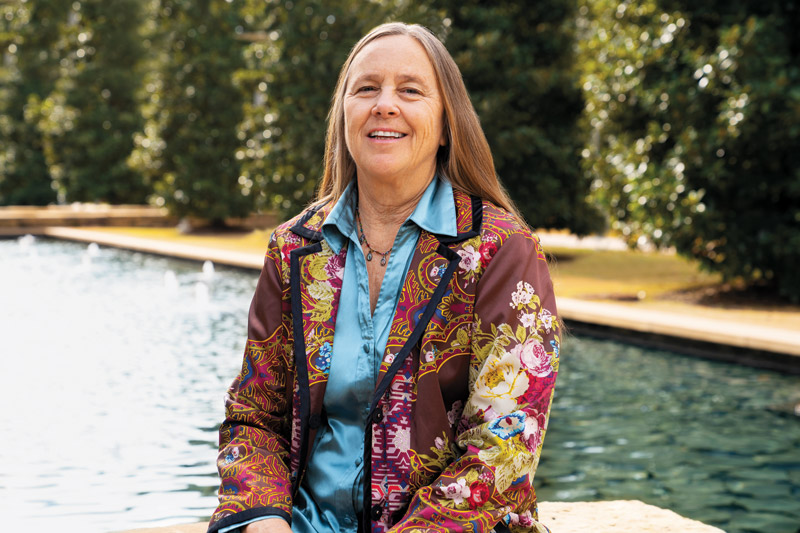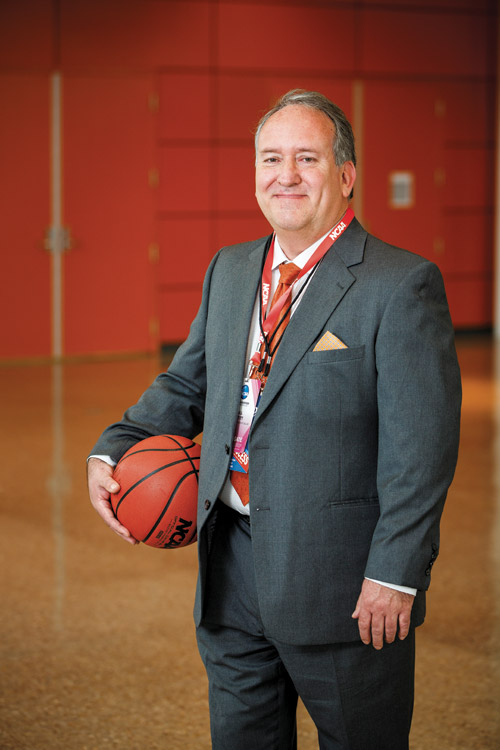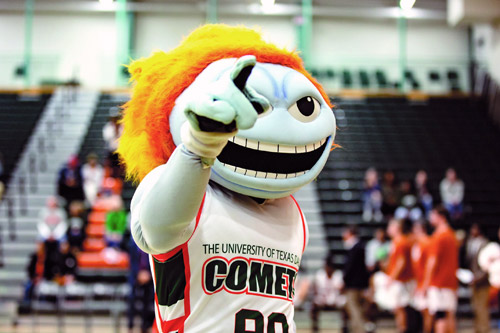A Winning Proposition
From club teams to NCAA championships, UT Dallas student-athletes build a legacy
By Bruce Unrue
When The University of Texas at Dallas’ first group of underclassmen arrived on campus in the late 1970s, administrators gradually realized that the younger students needed more to complete their “full college experience” than just well-equipped academic facilities and a world-renowned faculty.
They needed something to do.

Mary Walters, UT Dallas’ first director of athletics
So, as the University started building a student life program to keep students engaged as well as educated, Mary Walters joined the staff in 1981 as a recreational sports specialist, eventually becoming director of athletics in 1983.
“I was essentially an intramurals person,” she said. “But until we added freshmen and sophomores in the early 1990s, most of the students who were here were still more concerned with getting into grad school than being part of a team.
“I found some leftover vestiges of an athletics program from the early years — a few old uniforms, a bunch of paperwork — but nothing that had ever taken hold. Prior to that time, any athletic teams we did have were kind of haphazardly organized — more like club teams.”
Fast forward almost four decades and the UT Dallas athletics program has not only become a well-oiled machine under the auspices of the NCAA and American Southwest Conference, but the Comets also have become a nationally recognized powerhouse in many of the 14 sports that make up the varsity athletics program.
The legacy currently includes 32 conference championships and more than 30 teams representing UTD in NCAA national championship tournaments since 2002.
“We’ve grown from a regional program few people even in Dallas knew about to a national program that competes with some of the premier teams in the NCAA Division III,” said Bill Petitt, UT Dallas’ current director of athletics. “And we’ve been able to achieve this success without compromising UTD’s core values of academics. Our student-athletes have proved you can have both athletic and academic success.”
The program growth all happened quickly — and not without obstacles along the way.
“When I first arrived, we didn’t really have any facilities — a few tennis courts, a couple of ball fields and some basic soccer fields across campus that were used primarily by local youth programs,” Walters recalled. “I had to go rent middle school basketball courts a couple of nights a week just for intramurals.”
But in 1993, the student body voted to build an Activity Center that would include a full gymnasium, workout facility, racquetball courts and a swimming pool to house both recreational sports activities and an athletics program. Still, it would be five more years until the project was completed.
In the meantime, the undergraduate student body continued to grow, and the demand for varsity athletics increased — even if the UTD faculty wasn’t completely on board.
“There was resistance from some faculty members at that time who thought we might become a ‘football school.’ But that was never our intention,” Walters said.
“Nevertheless, we weren’t really ready to move forward at that point,” Walters explained. “We only had a couple of teams and part-time or volunteer coaches, and we didn’t have enough sports to qualify for NCAA membership. So, we joined the NAIA [National Association of Intercollegiate Athletics] just to get a schedule of games for our soccer team and the chance to advance if a team qualified.
Keeping Spirits High
With hair of fiery hue and skin of blue, Temoc is the personification of Comet spirit. (Temoc is “comet” spelled backward.) Developed in 1998 by Aaron Aryanpur BA’00, the University’s mascot was originally named Blaze. Temoc is part of the Comet spirit programs that also include the cheerleaders and the power dancers. The teams perform at varsity athletic and community events. In addition, the power dancers have appeared on ESPN’s “College GameDay,” “Good Morning Texas” and the Dallas Cowboys halftime show.
“The NAIA was a mixed bag,” she said. “Some schools had scholarships; others did not. And admissions standards were all over the map. It wasn’t unusual for us to have a game against a team made up of 30-year-olds. In addition, games were getting canceled all the time when an opposing school would decide not to make the trip. But we had no other option.”
By 1998, though, the Activity Center was nearing completion, and the student body was pushing for more sports and more organized activities. Walters proposed looking into NCAA Division III membership.
“The focus of UTD then — and now — has always been academics. I thought we fit philosophically with the NCAA Division III, which is all about putting academics first,” she said.
Coincidentally, there was a new Division III conference starting up — the American Southwest Conference — and the offices were just across Campbell Road from UT Dallas. Walters next contacted ASC Commissioner Fred Jacoby.
“He was amazing,” Walters said. “Fred was like someone’s grandfather. He was so delighted to talk with me, and he ended up walking us through the process step-by-step of joining the NCAA.
“I had reservations about Division III because we are a state school, and most of the schools in that division are small, private schools. But he assured me that we absolutely fit, and he helped smooth the path with other members of the ASC to get us an invitation to join. He was a great arbiter.”
At that time, the minimum number of sports required for NCAA membership was four for men and four for women. UTD added basketball and cross-country to its soccer and tennis programs, and hired full-time coaches for basketball and soccer. By 2002, when the University had completed its probationary period, baseball, softball and golf were also added.
On the Horizon
 Bill Petitt, current director of athletics
Bill Petitt, current director of athletics
What’s next for UT Dallas athletics? Look for indoor and outdoor men’s and women’s track and field beginning in fall 2020.
The new programs were announced in October and bring UTD’s total number of intercollegiate sports participating in NCAA Division III to 17; counting in esports brings the total to 18 sponsored varsity sports.
“We are excited to be adding men’s and women’s track and field to our program,” said Bill Petitt, athletic director. “We will start with distance events and transition into a full complement of track disciplines over the next three years. Additionally, by adding track and field, we will give our cross-country program the resources to compete at an elite level.”
The first year (2002) the Comets were eligible as full-fledged NCAA members, UTD battled for both men’s and women’s ASC soccer titles, with the women winning the conference championship.
And the Comets have not looked back.
After a slow start, both men’s and women’s basketball teams won four ASC titles over the past 15 years. Volleyball was added in 2003, qualified for the ASC championship tournament every season and won six conference titles. Soccer has continued to be a dominant force with the men and women combining for seven ASC titles. Men’s and women’s tennis have two championships apiece, and the men’s and women’s cross-country teams are among the conference’s best, each winning championships in the past four seasons. Baseball and softball each have an ASC title, too.
And, the athletics program’s newest member — esports (competitive video gaming) — won a national tournament in its first season.
“This is kind of what I envisioned,” said Walters, who served as athletics director until 2003. “It’s pleased me that — even as UTD has grown — the student body has gotten so involved and more and more behind it. When we started out, the teams were playing mostly in front of parents. Today, you see the stands packed with loud, boisterous UTD students eager to cheer on their teams.
“The student-athletes have made UTD athletics such a success, and they are great ambassadors for the University.”



 Bill Petitt, current director of athletics
Bill Petitt, current director of athletics


